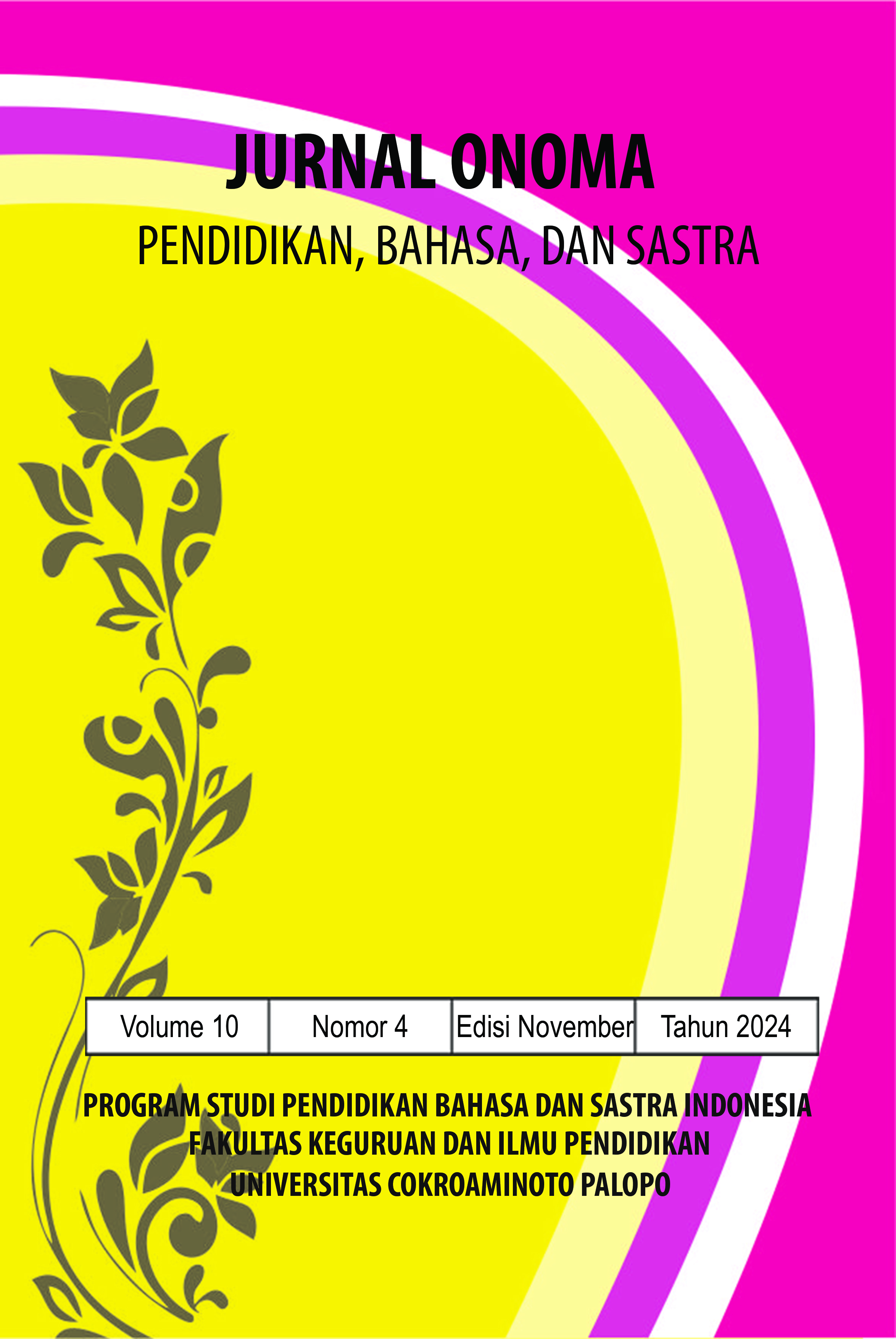Syntax Acquisition in Children: Developmental Patterns and Cognitive Processes
https://doi.org/10.30605/onoma.v10i4.4223
Keywords:
Syntactic development, Socioeconomic status (SES), Bilingualism, Early interventions, Language developmentAbstract
This research looks into the complicated steps kids take to learn grammar, focusing on how socioeconomic status (SES), being bilingual, and getting help early on affect this process. The introduction shows how important it is to understand how syntax develops in order to make educational practices more effective and open to everyone. To test syntactic learning, the method uses a mix of experimental, quasi-experimental, and naturalistic observation methods. Structured experiments and longitudinal studies are two important ways to study language development over time. Structured experiments control variables and measure syntactic knowledge and production. The results show that SES has a big effect on how syntax develops, with environments with higher SES giving stronger linguistic input. When learning grammar, being bilingual can be both hard and helpful, depending on how old you are when you start learning and how often you use the language. Children who are at risk of language delays gain a lot from early interventions, especially those that focus on improving phonological awareness and vocabulary. The talk makes it clear that early and focused interventions are needed to reduce differences in outcomes based on socioeconomic status and improve the development of syntax in both bilingual and monolingual children. The results support using research-based linguistic knowledge in the classroom to help all students do better with language, but especially those who have developmental language problems.
Downloads
References
A, A. M., R, E. H., & Uccelli, P. (2021). Lenguajes para el aprendizaje. 58(2). https://doi.org/10.7764/pel.58.2.2021.1 DOI: https://doi.org/10.7764/PEL.58.2.2021.1
Abu-Hamour, B., Urso, A., & Mather, N. (2012). The Application of Standardized Assessments and CBM Measures in a Case Study of a Student With a Severe Reading Disability. Reading & Writing Quarterly, 29(1), 44–63. https://doi.org/10.1080/10573569.2013.741950 DOI: https://doi.org/10.1080/10573569.2013.741950
Breuer, H., Baloian, N., Sousa, C., & Matsumoto, M. (2007). Interaction Design Patterns for Classroom Environments. In Lecture notes in computer science (pp. 163–172). https://doi.org/10.1007/978-3-540-73111-5_19 DOI: https://doi.org/10.1007/978-3-540-73111-5_19
Downey, G., Zaki, J., Berenson, K. R., Gur, R. C., & Brodkin, E. S. (2015). Cognitive Psychology and Neuroscience. Psychiatry, 435–452. https://doi.org/10.1002/9781118753378.ch26 DOI: https://doi.org/10.1002/9781118753378.ch26
Fonteyn, L. (2016). From nominal to verbal gerunds. Functions of Language, 23(1), 60–83. https://doi.org/10.1075/fol.23.1.04fon DOI: https://doi.org/10.1075/fol.23.1.04fon
Hura, D., & Agustina, N. (2020). Obtaining Language in Children 2.5 Aged Years Old Phonology and Syntax Study. Proceedings of the 1st Progress in Social Science, Humanities and Education Research Symposium (PSSHERS 2019). https://doi.org/10.2991/assehr.k.200824.029 DOI: https://doi.org/10.2991/assehr.k.200824.029
Oh, J. Y., & Jung, K. (2021). A Case Study on the Effect of Vocabulary Intervention Program Based on Morphological Awareness of Children with Language Learning Disability. Audiology and Speech Research, 17(2), 241–253. https://doi.org/10.21848/asr.200074 DOI: https://doi.org/10.21848/asr.200074
SOLO, R., & TORAJA, M. T. (2023). Universitas Cokroaminoto Palopo, suparman@ uncp. ac. id. Jurnal Penelitian Pendidikan, 8(1).
Osman, D. M., Shohdi, S., & Aziz, A. A. (2011). Pragmatic difficulties in children with Specific Language Impairment. International Journal of Pediatric Otorhinolaryngology, 75(2), 171–176. https://doi.org/10.1016/j.ijporl.2010.10.028 DOI: https://doi.org/10.1016/j.ijporl.2010.10.028
Partington, A. (2011). Phrasal irony: Its form, function and exploitation. Journal of Pragmatics, 43(6), 1786–1800. https://doi.org/10.1016/j.pragma.2010.11.001 DOI: https://doi.org/10.1016/j.pragma.2010.11.001
Salim, J. A., & Mehawesh, M. (2014). Stages in Language Acquisition: A Case Study. English Language and Literature Studies, 4(4). https://doi.org/10.5539/ells.v4n4p16 DOI: https://doi.org/10.5539/ells.v4n4p16
Satyan, U. (2020). Content Analysis: Pop-Songs in the English Language Teaching Classes. Journal of NELTA Gandaki 246 33 JoNG/Journal of NELTA Gandaki, 3(1–2), 36–44. https://doi.org/10.3126/jong.v3i1-2.33143 DOI: https://doi.org/10.3126/jong.v3i1-2.33143
Shuang, C., & Weichao, W. (2022). Interpersonal Meaning in Apple New Product Launches: An Analysis of Tim Cook’s Speeches Based on AIDA Model. Sumerianz Journal of Education, Linguistics and Literature, 54, 71–79. https://doi.org/10.47752/sjell.54.71.79 DOI: https://doi.org/10.47752/sjell.54.71.79
Tager-Flusberg, H., & Seery, A. (2013a). Early Development of Speech and Language. In Elsevier eBooks (pp. 315–330). https://doi.org/10.1016/b978-0-12-397267-5.00148-5 DOI: https://doi.org/10.1016/B978-0-12-397267-5.00148-5
Tan, L. (2011). Divergences in the English-language News Media in Singapore. Asian Englishes, 14(2), 4–20. https://doi.org/10.1080/13488678.2011.10801304 DOI: https://doi.org/10.1080/13488678.2011.10801304
Visser-Bochane, M. I., Reijneveld, S. A., Krijnen, W. P., Van Der Schans, C. P., & Luinge, M. R. (2020). Identifying Milestones in Language Development for Young Children Ages 1 to 6 Years. Academic Pediatrics, 20(3), 421–429. https://doi.org/10.1016/j.acap.2019.07.003 DOI: https://doi.org/10.1016/j.acap.2019.07.003
Wagenmakers, E. J. (2009). Teaching graduate students how to write clearly. Universiteit van Amsterdam. https://hdl.handle.net/11245/1.313070
Ward, N. (2006). Non-lexical conversational sounds in American English. Pragmatics & Cognition, 14(1), 129–182. https://doi.org/10.1075/pc.14.1.08war DOI: https://doi.org/10.1075/pc.14.1.08war
Downloads
Published
How to Cite
License
In submitting the manuscript to the journal, the authors certify that:
- They are authorized by their co-authors to enter into these arrangements.
- The work described has not been formally published before, except in the form of an abstract or as part of a published lecture, review, thesis, or overlay journal.
- That it is not under consideration for publication elsewhere,
- That its publication has been approved by all the author(s) and by the responsible authorities – tacitly or explicitly – of the institutes where the work has been carried out.
- They secure the right to reproduce any material that has already been published or copyrighted elsewhere.
- They agree to the following license and copyright agreement.
License and Copyright Agreement
Authors who publish with Onoma Journal: Education, Languages??, and Literature agree to the following terms:
- Authors retain copyright and grant the journal right of first publication with the work simultaneously licensed under Creative Commons Attribution License (CC BY 4.0) that allows others to share the work with an acknowledgment of the work's authorship and initial publication in this journal.
- Authors are able to enter into separate, additional contractual arrangements for the non-exclusive distribution of the journal's published version of the work (e.g., post it to an institutional repository or publish it in a book), with an acknowledgment of its initial publication in this journal.
- Authors are permitted and encouraged to post their work online (e.g., in institutional repositories or on their website) prior to and during the submission process, as it can lead to productive exchanges, as well as earlier and greater citation of published work.

















